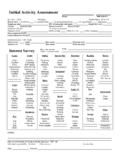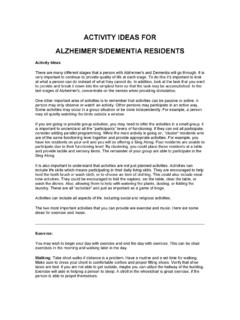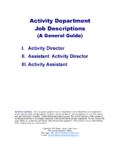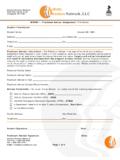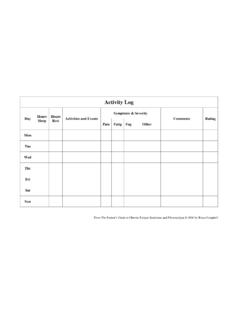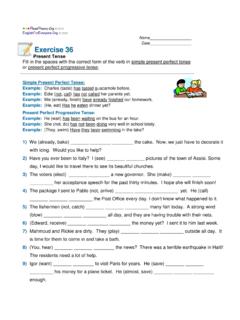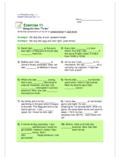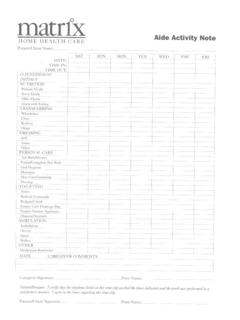Transcription of CMS Manual System F248, F249 - Activity Director …
1 1 CMS Manual System Department of Health & Human Services (DHHS) Pub. 100-07 State Operations Provider Certification Centers for Medicare & Medicaid Services (CMS)Transmittal Date: SUBJECT: Guidance to Surveyors of Long Term Care Facilities I. SUMMARY OF CHANGES: State Operations Manual , Appendix PP, f248 , Activities and f249 , Activity Director Guidance to Surveyors is entirely replaced with new Guidance, attached. (Regulation language is unchanged.) NEW/REVISED MATERIAL - EFFECTIVE DATE*: Upon Issuance IMPLEMENTATION DATE: Upon Issuance Disclaimer for Manual changes only: The revision date and transmittal number apply to the red italicized material only.
2 Any other material was previously published and remains unchanged. However, if this revision contains a table of contents, you will receive the new/revised information only, and not the entire table of contents. II. CHANGES IN Manual INSTRUCTIONS: (N/A if Manual not updated.) (R = REVISED, N = NEW, D = DELETED) (Only One Per Row.) R/N/D CHAPTER/SECTION/SUBSECTION/TITLE R Appendix PP/ f248 , Activities and f249 , Activity Director III. FUNDING: Medicare contractors shall implement these instructions within their current operating budgets. IV. ATTACHMENTS: Business Requirements x Manual Instruction Confidential Requirements One-Time Notification Recurring Update Notification *Unless otherwise specified, the effective date is the date of service.
3 2F248 (Rev.) (f) Activities (f)(1) The facility must provide for an ongoing program of activities designed to meet, in accordance with the comprehensive assessment, the interests and the physical, mental, and psychosocial well-being of each resident. INTENT: (f)(1) Activities The intent of this requirement is that: The facility identifies each resident's interests and needs; and The facility involves the resident in an ongoing program of activities that is designed to appeal to his or her interests and to enhance the resident's highest practicable level of physical, mental, and psychosocial well-being. DEFINITIONS Definitions are provided to clarify key terms used in this guidance. Activities refer to any endeavor, other than routine ADLs, in which a resident participates that is intended to enhance her/his sense of well-being and to promote or enhance physical, cognitive, and emotional health.
4 These include, but are not limited to, activities that promote self-esteem, pleasure, comfort, education, creativity, success, and independence. NOTE: ADL-related activities, such as manicures/pedicures, hair styling, and makeovers, may be considered part of the activities program. One-to-One Programming refers to programming provided to residents who will not, or cannot, effectively plan their own Activity pursuits, or residents needing specialized or extended programs to enhance their overall daily routine and Activity pursuit needs. Person Appropriate refers to the idea that each resident has a personal identity and history that involves more than just their medical illnesses or functional impairments. Activities should be relevant to the specific needs, interests, culture, background, etc.
5 Of the individual for whom they are developed. 3 Program of Activities includes a combination of large and small group, one-to-one, and self-directed activities; and a System that supports the development, implementation, and evaluation of the activities provided to the residents in the OVERVIEW In long term care, an ongoing program of activities refers to the provision of activities in accordance with and based upon an individual resident s comprehensive assessment. The Institute of Medicine (IOM) s 1986 report, Improving the Quality of Care in Nursing Homes, became the basis for the Nursing Home Reform part of OBRA 87 and the current OBRA long term care regulations. The IOM Report identified the need for residents in nursing homes to receive care and/or services to maximize their highest practicable quality of life.
6 However, defining quality of life has been difficult, as it is subjective for each person. Thus, it is important for the facility to conduct an individualized assessment of each resident to provide additional opportunities to help enhance a resident s self-esteem and dignity. Research findings and the observations of positive resident outcomes confirm that activities are an integral component of residents lives. Residents have indicated that daily life and involvement should be meaningful. Activities are meaningful when they reflect a person s interests and lifestyle, are enjoyable to the person, help the person to feel useful, and provide a sense of Residents Views on Activities Activities are relevant and valuable to residents quality of life.
7 In a large-scale study commissioned by CMS, 160 residents in 40 nursing homes were interviewed about what quality of life meant to them. The study found that residents overwhelmingly assigned priority to dignity, although they labeled this concern in many ways. The researchers determined that the two main components of dignity, in the words of these residents, were independence and positive self-image. Residents listed, under the categories of independence and positive self-image, the elements of choice of activities and activities that amount to something, such as those that produce or teach something; activities using skills from residents former work; religious activities; and activities that contribute to the nursing home.
8 The report stated that, Residents not only discussed particular activities that gave them a sense of purpose but also indicated that a lack of appropriate activities contributes to having no sense of purpose. Residents rarely mentioned participating in activities as a way to just keep busy or just to socialize..The relevance of the activities to the residents lives must be considered. According to the study, residents wanted a variety of activities, including those that are not childish, require thinking (such as word games), are gender-specific, produce something useful, relate to previous work of residents, allow for socializing with visitors and participating in community events, and are physically active. The study found that the above concepts were relevant to both interviewable and non-interviewable residents.
9 Researchers observed that non-interviewable residents appeared happier and less agitated in homes with many planned activities for them. 4 Non-traditional Approaches to Activities Surveyors need to be aware that some facilities may take a non-traditional approach to activities. In neighborhoods/households, all staff may be trained as nurse aides and are responsible to provide activities, and activities may resemble those of a private Residents, staff, and families may interact in ways that reflect daily life, instead of in formal activities programs. Residents may be more involved in the ongoing activities in their living area, such as care-planned approaches including chores, preparing foods, meeting with other residents to choose spontaneous activities, and leading an Activity .
10 It has been reported that, some culture changed homes might not have a traditional activities calendar, and instead focus on community life to include activities. Instead of an activities Director , some homes have a Community Life Coordinator, a Community Developer, or other title for the individual directing the activities For more information on activities in homes changing to a resident-directed culture, the following websites are available as resources: ; ; (click on nursing homes); and ASSESSMENT The information gathered through the assessment process should be used to develop the activities component of the comprehensive care plan. The ongoing program of activities should match the skills, abilities, needs, and preferences of each resident with the demands of the Activity and the characteristics of the physical, social and cultural In order to develop individualized care planning goals and approaches, the facility should obtain sufficient, detailed information (even if the Activities RAP is not triggered) to determine what activities the resident prefers and what adaptations, if any, are The facility may use, but need not duplicate, information from other sources, such as the RAI, including the RAPs, assessments by other disciplines, observation, and resident and family interviews.


